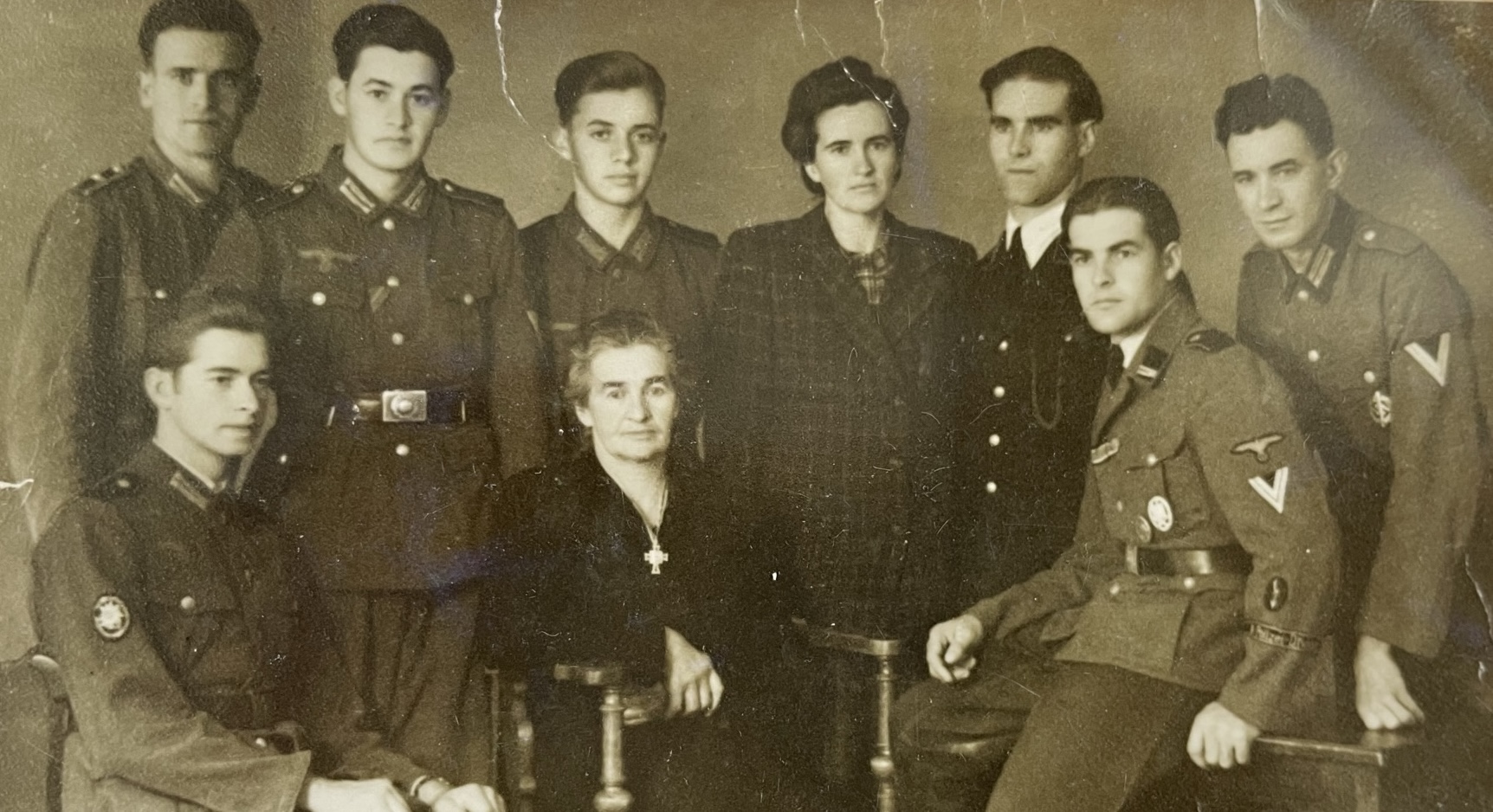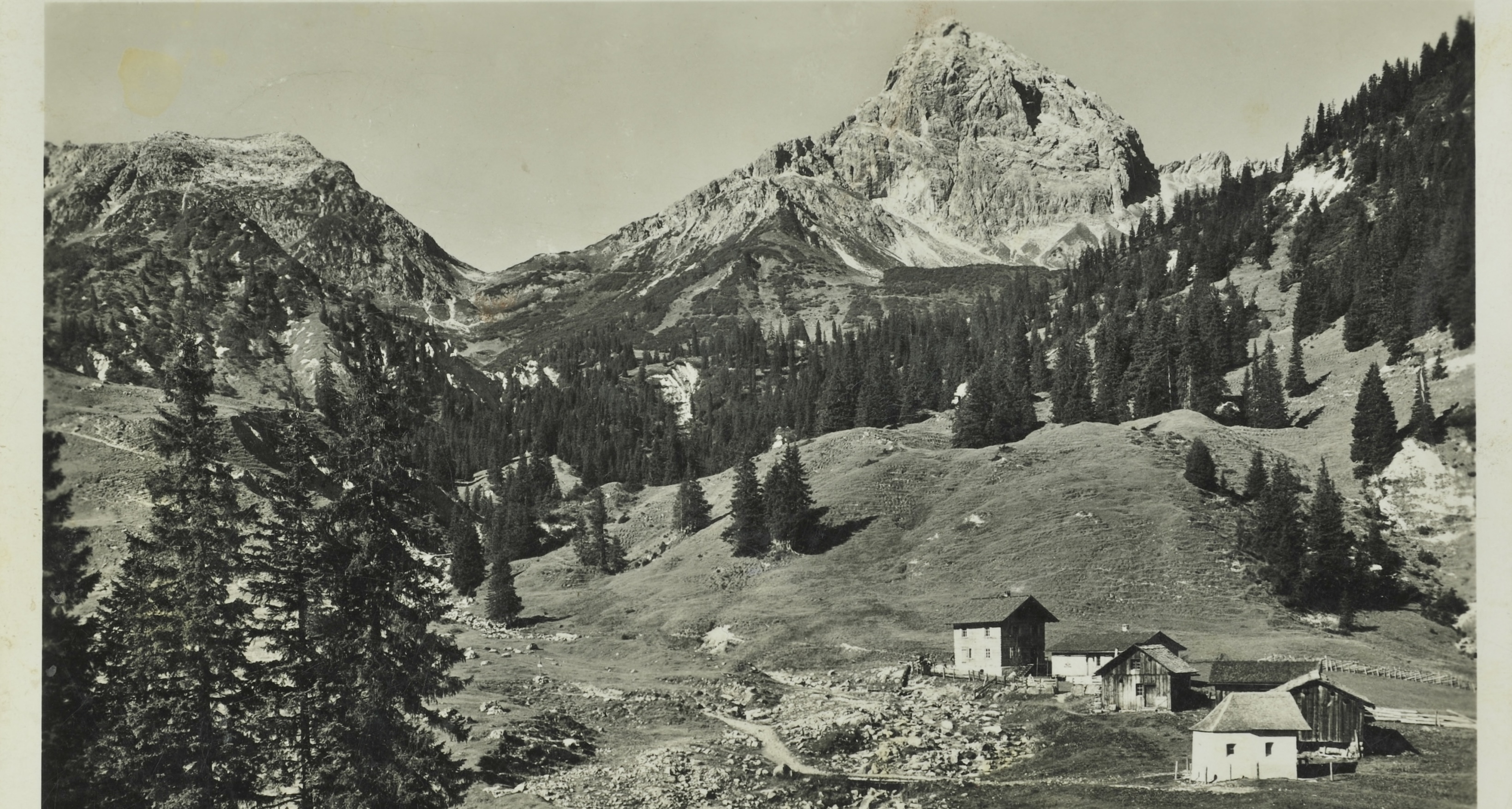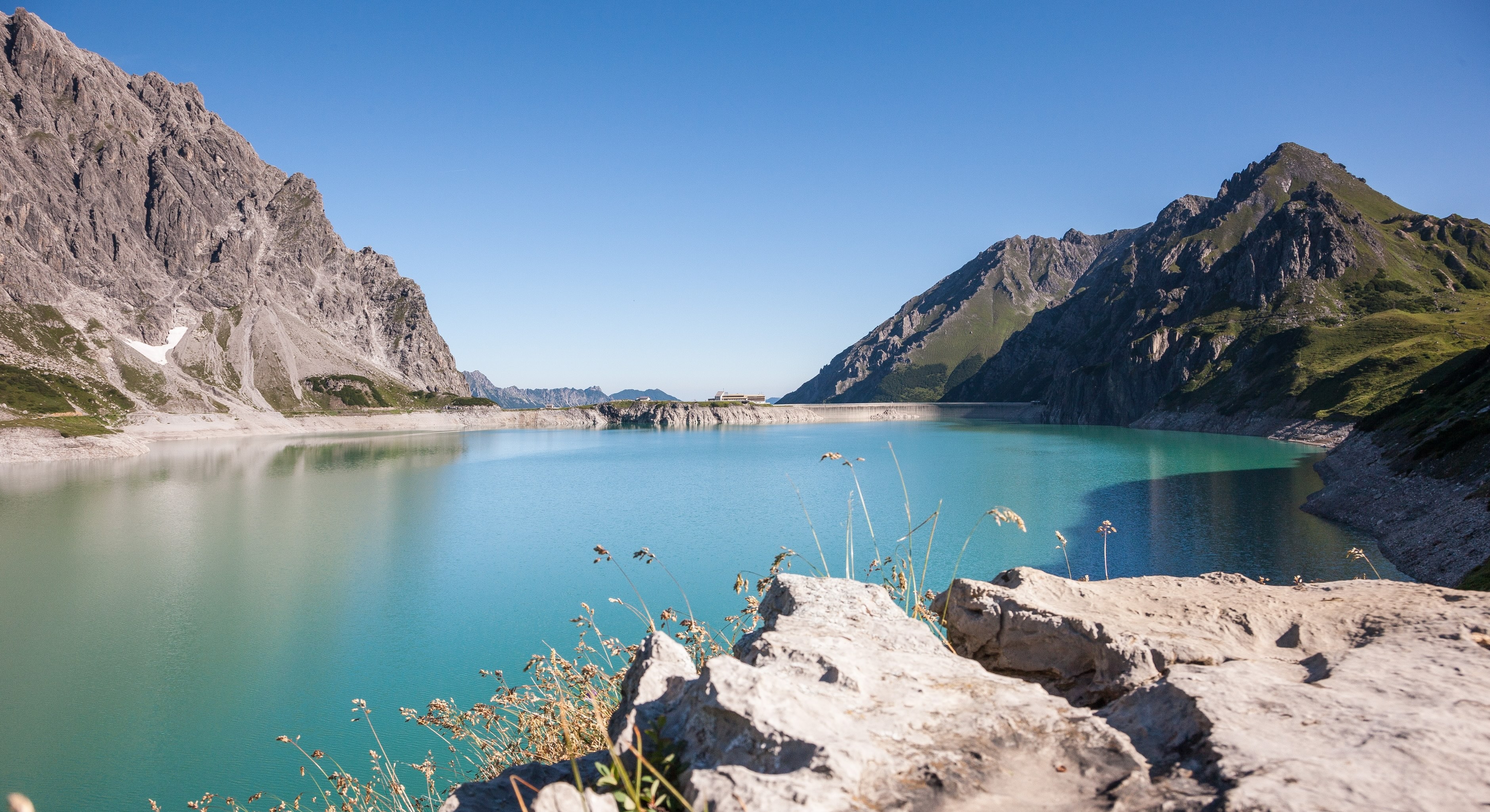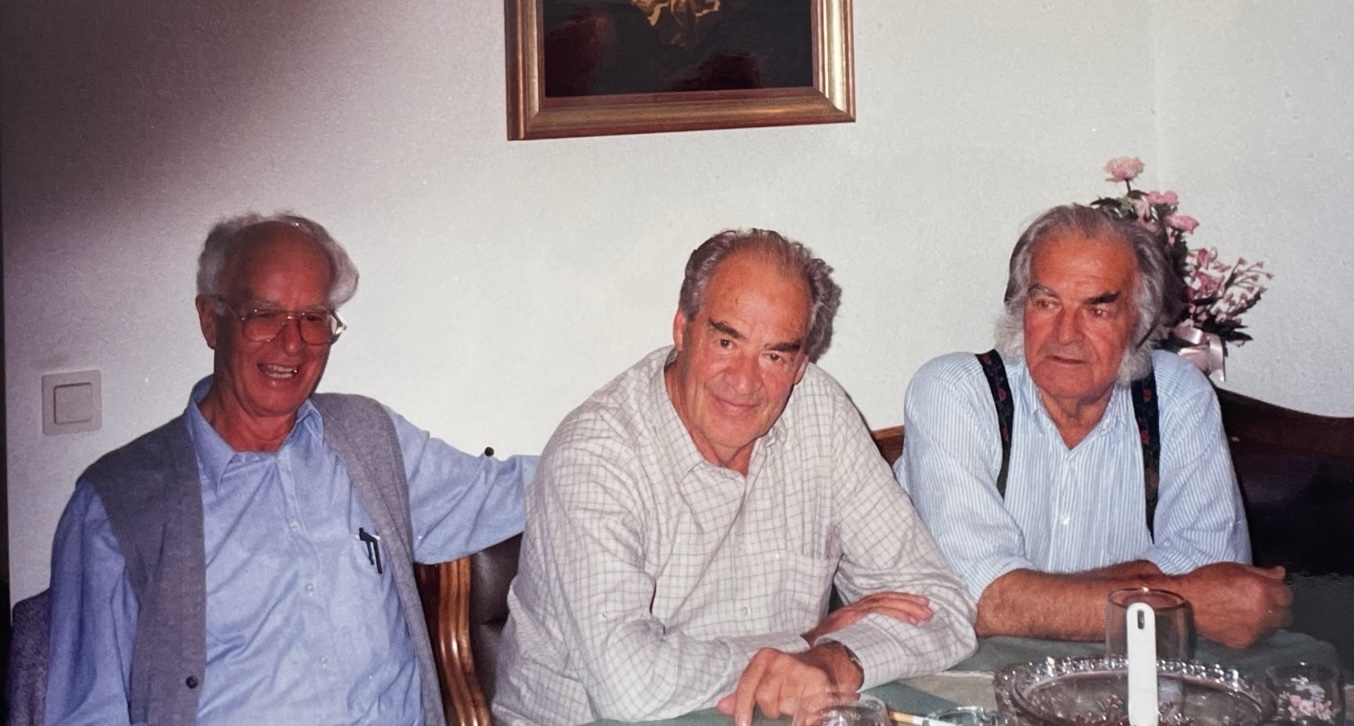Erwin, Kurt and Fritz Müller> October 10, 1943
42c Erwin, Kurt and Fritz Müller
Erwin, Kurt and Fritz Müller make it through the Rellstal valley to the ‘Swiss Portal’
Nüziders-Vandans-Hohenweiler, October 10, 1943 [1]
The fifth year of the war has begun in Europe when the brothers Erwin, Kurt and Fritz Müller happen to be on furlough in their home country at the same time. The newly promoted SS-Rottenführer Erwin Müller arrives from Lithuania at the end of September 1943. His brother Kurt had already traveled to Vorarlberg from the north of Finland a week earlier. Fritz, who has also been in the service of the Wehrmacht for nine months, is not so far away since September 10. The 19-year-old had already been transferred from the Eastern Front to a military hospital on the Moselle in the summer due to knee inflammation. Their mother Maria, who had returned to Vorarlberg from Styria with her children around 1926 after separating from her second husband, was particularly hard hit by the war. Six of her seven sons were deployed in the war. The small farm in Hohenweiler, where they had lived since 1937, had visibly emptied out.
The three brothers arriving in Hohenweiler in September 1943 use their unexpected meeting to talk about their experiences. Experiences that led to their decision to extend their furlough indefinitely. Of course, they first had to get out of the German Reich illegally. And on October 14, 1943, at the police station in Buchs, Switzerland, they recall how they managed to do this. Fritz Müller testifies:
“As we were not in favor of the German regime anyway and wanted to become Austrians again, we decided to escape. We didn't want to sacrifice our young lives for a hopeless cause or end up crippled later on.”[2]
The three of them would have preferred to take their brother Adalbert with them, but he didn't dare leave the barracks in Innsbruck without permission. One day after Erwin Müller tried to persuade him to come with them to Innsbruck, Adalbert wrote to his mother in Hohenweiler:
“I didn't go with them. I'm very curious to see how they do it.”[3]
The three brothers probably started to think about their escape plans only during their leave at home. It is also possible that the bombing of Feldkirch by US planes on October 1 encouraged them to do so. However, Fritz Müller's upcoming end of his leave was probably the decisive factor. It was time to act.
The date for their arrival in Landeck on October 9 also offered the opportunity to move together towards the Arlberg. So Fritz and Kurt Müller (who pretended to want to say goodbye to his brother) boarded a train to Bludenz that day. Their secret destination is of course Nüziders, one stop before Bludenz. At lunchtime they met their brother Erwin there as planned, who had already come to Nüziders the day before and was probably staying with his girlfriend Lina Dressel. Right next door is the house of the Müllers' much older half-brother, Arnold Berlinger, who was stationed in Hall in Tyrol at the time.
They set off in the late evening of October 10 and make it on foot before dawn to the Rellstal valley, which leads from the Montafon village of Vandans up to the Swiss border. Another two nights later, they cross the ‘Swiss portal’, the pass near Lake Lünersee.
They hide their uniforms and three military pistols with ammunition under a stone and hand themselves in to a Swiss patrol. In Buchs, Kurt Müller puts their story on record:
“We only hiked at night and stayed hidden during the day. For this reason our progress was slow. Between 0500 and 0600, Wednesday the 13th, we passed the German-Swiss border unhindered. Before reaching Schuders we spoke to 2 Swiss soldiers.“[4]
Recognized as deserters by the Swiss authorities, the Müller brothers are taken to an internment camp, as has been customary since 1942.
Initially, they are interned at Dietschiberg near Lucerne and probably also questioned for military information. At the end of October, they are transferred to a deserters' camp in Unterrealta in Graubünden. However, the letters they send home from there do not reach their destination. The Gestapo intercepts them.
At the beginning of February 1944, the trio is finally transferred to the Stalden camp near Bözberg in the canton of Aargau and assigned to work for various farmers. Four months later, Erwin Müller can't stand it there any longer, he is homesick. He had already failed in December after an escape attempt halfway to the border. Now he leaves his job and makes his way from the canton of Aargau towards Vorarlberg, taking the same route back to the ‚Swiss portal‘.
After a day and a half, he crosses the border pass in the Rätikon, shrouded in fog, shortly before midnight, carrying the three pistols he had retrieved from hiding.
Not far from the Rellstal chapel, at around 2 a.m. on June 8, he comes across a border guard and a gunfight ensues. The assistant customs officer Wilhelm Tschabrun is fatally shot and Müller escapes imminent arrest. Distraught, he arrives at his girlfriend Lina Dressel's house in Nüziders late the same day and takes refuge with her. While the newspapers report the death of the assistant customs officer, Erwin Müller continues on his way and reaches Hohenweiler a few days later.
He succeeds in hiding in his mother's house until shortly before the end of the war. His presence did not go unnoticed in the small community, but nobody would betray him. On May 8, 1945, the Second World War in Europe ends with the complete surrender of the Wehrmacht. A war from which the youngest Müller brother, Adalbert, did not return. He had been killed in action in Upper Silesia just over three months earlier. Kurt and Fritz Müller, on the other hand, did not cross the border at St. Margrethen until the end of the year, together with more than 450 other interned Austrians. Both marry and return to civilian working life. And Erwin Müller? In 1949, he had to stand trial for the fatal use of firearms and claimed to have acted in self-defense. He served a prison sentence in Garsten, Upper Austria, until 1953.
Recommended Reading:
Nikolaus Hagen, „‚Wir wollten unser junges Leben nicht für eine aussichtslose Sache opfern‘. Der Fall der Brüder Erwin, Kurt und Fritz Müller“, in: Peter Pirker/Ingrid Böhler (Ed.), Flucht vor dem Krieg. Deserteure der Wehrmacht in Vorarlberg (Forschungen zur Geschichte Vorarlbergs, hrsg. v. Vorarlberger Landesarchiv, Band 15). Tübingen 2023, p. 303-330.
[1] The documentation of the story of Erwin, Kurt and Fritz Müller is the result of meticulous research by Nikolaus Hagen as part of the research project carried out at the Institute of Contemporary History at the University of Innsbruck between 2019 and 2022 ‚Deserteure der Wehrmacht im Reichsgau Tirol und Vorarlberg. Verweigerungsformen, Verfolgung, Solidarität, Vergangenheitspolitik‘, lead by Peter Pirker.
[2] Kantonspolizei St. Gallen Posten Buchs 2, Police interrogation of Fritz Müller, October 14, 1943. Schweizerisches Bundesarchiv (BAR), E4264#1985/196#22550*; quoted from Nikolaus Hagen, „Wir wollten unser junges Leben nicht für eine aussichtslose Sache opfern‘. Der Fall der Brüder Erwin, Kurt und Fritz Müller“, in: Peter Pirker/Ingrid Böhler (Ed.), Flucht vor dem Krieg. Deserteure der Wehrmacht in Vorarlberg (Forschungen zur Geschichte Vorarlbergs, hrsg. v. Vorarlberger Landesarchiv, Band 15). Tübingen 2023, p. 303-330, here p. 303.
[3] Adalbert Müller to Maria Berlinger, letter from October 10, 1942 (transcript of February 18, 1944). BArch-MA, Pers 15/146444, fol. 12; quoted from Hagen, Der Fall der Brüder Müller, p. 318.
[4] Kantonspolizei St. Gallen Posten Buchs 2, Police interrogation of Kurt Müller, October 14, 1943. BAR, E4264#1985/196#22550*; quoted from Hagen, Der Fall der Brüder Müller, p. 319.
42c Erwin, Kurt and Fritz Müller
Erwin, Kurt and Fritz Müller make it through the Rellstal valley to the ‘Swiss Portal’
Nüziders-Vandans-Hohenweiler, October 10, 1943 [1]
The fifth year of the war has begun in Europe when the brothers Erwin, Kurt and Fritz Müller happen to be on furlough in their home country at the same time. The newly promoted SS-Rottenführer Erwin Müller arrives from Lithuania at the end of September 1943. His brother Kurt had already traveled to Vorarlberg from the north of Finland a week earlier. Fritz, who has also been in the service of the Wehrmacht for nine months, is not so far away since September 10. The 19-year-old had already been transferred from the Eastern Front to a military hospital on the Moselle in the summer due to knee inflammation. Their mother Maria, who had returned to Vorarlberg from Styria with her children around 1926 after separating from her second husband, was particularly hard hit by the war. Six of her seven sons were deployed in the war. The small farm in Hohenweiler, where they had lived since 1937, had visibly emptied out.
The three brothers arriving in Hohenweiler in September 1943 use their unexpected meeting to talk about their experiences. Experiences that led to their decision to extend their furlough indefinitely. Of course, they first had to get out of the German Reich illegally. And on October 14, 1943, at the police station in Buchs, Switzerland, they recall how they managed to do this. Fritz Müller testifies:
“As we were not in favor of the German regime anyway and wanted to become Austrians again, we decided to escape. We didn't want to sacrifice our young lives for a hopeless cause or end up crippled later on.”[2]
The three of them would have preferred to take their brother Adalbert with them, but he didn't dare leave the barracks in Innsbruck without permission. One day after Erwin Müller tried to persuade him to come with them to Innsbruck, Adalbert wrote to his mother in Hohenweiler:
“I didn't go with them. I'm very curious to see how they do it.”[3]
The three brothers probably started to think about their escape plans only during their leave at home. It is also possible that the bombing of Feldkirch by US planes on October 1 encouraged them to do so. However, Fritz Müller's upcoming end of his leave was probably the decisive factor. It was time to act.
The date for their arrival in Landeck on October 9 also offered the opportunity to move together towards the Arlberg. So Fritz and Kurt Müller (who pretended to want to say goodbye to his brother) boarded a train to Bludenz that day. Their secret destination is of course Nüziders, one stop before Bludenz. At lunchtime they met their brother Erwin there as planned, who had already come to Nüziders the day before and was probably staying with his girlfriend Lina Dressel. Right next door is the house of the Müllers' much older half-brother, Arnold Berlinger, who was stationed in Hall in Tyrol at the time.
They set off in the late evening of October 10 and make it on foot before dawn to the Rellstal valley, which leads from the Montafon village of Vandans up to the Swiss border. Another two nights later, they cross the ‘Swiss portal’, the pass near Lake Lünersee.
They hide their uniforms and three military pistols with ammunition under a stone and hand themselves in to a Swiss patrol. In Buchs, Kurt Müller puts their story on record:
“We only hiked at night and stayed hidden during the day. For this reason our progress was slow. Between 0500 and 0600, Wednesday the 13th, we passed the German-Swiss border unhindered. Before reaching Schuders we spoke to 2 Swiss soldiers.“[4]
Recognized as deserters by the Swiss authorities, the Müller brothers are taken to an internment camp, as has been customary since 1942.
Initially, they are interned at Dietschiberg near Lucerne and probably also questioned for military information. At the end of October, they are transferred to a deserters' camp in Unterrealta in Graubünden. However, the letters they send home from there do not reach their destination. The Gestapo intercepts them.
At the beginning of February 1944, the trio is finally transferred to the Stalden camp near Bözberg in the canton of Aargau and assigned to work for various farmers. Four months later, Erwin Müller can't stand it there any longer, he is homesick. He had already failed in December after an escape attempt halfway to the border. Now he leaves his job and makes his way from the canton of Aargau towards Vorarlberg, taking the same route back to the ‚Swiss portal‘.
After a day and a half, he crosses the border pass in the Rätikon, shrouded in fog, shortly before midnight, carrying the three pistols he had retrieved from hiding.
Not far from the Rellstal chapel, at around 2 a.m. on June 8, he comes across a border guard and a gunfight ensues. The assistant customs officer Wilhelm Tschabrun is fatally shot and Müller escapes imminent arrest. Distraught, he arrives at his girlfriend Lina Dressel's house in Nüziders late the same day and takes refuge with her. While the newspapers report the death of the assistant customs officer, Erwin Müller continues on his way and reaches Hohenweiler a few days later.
He succeeds in hiding in his mother's house until shortly before the end of the war. His presence did not go unnoticed in the small community, but nobody would betray him. On May 8, 1945, the Second World War in Europe ends with the complete surrender of the Wehrmacht. A war from which the youngest Müller brother, Adalbert, did not return. He had been killed in action in Upper Silesia just over three months earlier. Kurt and Fritz Müller, on the other hand, did not cross the border at St. Margrethen until the end of the year, together with more than 450 other interned Austrians. Both marry and return to civilian working life. And Erwin Müller? In 1949, he had to stand trial for the fatal use of firearms and claimed to have acted in self-defense. He served a prison sentence in Garsten, Upper Austria, until 1953.
Recommended Reading:
Nikolaus Hagen, „‚Wir wollten unser junges Leben nicht für eine aussichtslose Sache opfern‘. Der Fall der Brüder Erwin, Kurt und Fritz Müller“, in: Peter Pirker/Ingrid Böhler (Ed.), Flucht vor dem Krieg. Deserteure der Wehrmacht in Vorarlberg (Forschungen zur Geschichte Vorarlbergs, hrsg. v. Vorarlberger Landesarchiv, Band 15). Tübingen 2023, p. 303-330.
[1] The documentation of the story of Erwin, Kurt and Fritz Müller is the result of meticulous research by Nikolaus Hagen as part of the research project carried out at the Institute of Contemporary History at the University of Innsbruck between 2019 and 2022 ‚Deserteure der Wehrmacht im Reichsgau Tirol und Vorarlberg. Verweigerungsformen, Verfolgung, Solidarität, Vergangenheitspolitik‘, lead by Peter Pirker.
[2] Kantonspolizei St. Gallen Posten Buchs 2, Police interrogation of Fritz Müller, October 14, 1943. Schweizerisches Bundesarchiv (BAR), E4264#1985/196#22550*; quoted from Nikolaus Hagen, „Wir wollten unser junges Leben nicht für eine aussichtslose Sache opfern‘. Der Fall der Brüder Erwin, Kurt und Fritz Müller“, in: Peter Pirker/Ingrid Böhler (Ed.), Flucht vor dem Krieg. Deserteure der Wehrmacht in Vorarlberg (Forschungen zur Geschichte Vorarlbergs, hrsg. v. Vorarlberger Landesarchiv, Band 15). Tübingen 2023, p. 303-330, here p. 303.
[3] Adalbert Müller to Maria Berlinger, letter from October 10, 1942 (transcript of February 18, 1944). BArch-MA, Pers 15/146444, fol. 12; quoted from Hagen, Der Fall der Brüder Müller, p. 318.
[4] Kantonspolizei St. Gallen Posten Buchs 2, Police interrogation of Kurt Müller, October 14, 1943. BAR, E4264#1985/196#22550*; quoted from Hagen, Der Fall der Brüder Müller, p. 319.




